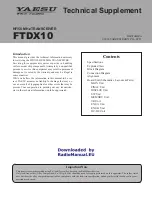
116
Virtex-5 RocketIO GTP Transceiver User Guide
UG196 (v1.3) May 25, 2007
Chapter 6:
GTP Transmitter (TX)
R
PCI Express Receive Detect Support
Overview
The GTP transceiver supports receiver detect functionality as defined by the
PHY Interface
for PCI Express (PIPE) Specification
. This function drives the TX link to one state followed by
a second state and then measures the time required for the link voltage to change. The PIPE
specification provides details about the receiver detection mechanism.
Ports and Attributes
shows the ports associated with this function.
Table 6-19:
PCI Express Receive Detect Support Ports
Port
Dir
Domain
Description
PHYSTATUS0
PHYSTATUS1
Out
Async
This signal is asserted High to indicate completion of several PHY
functions, including power management state transitions and
receiver detection. When this signal transitions during entry and exit
from P2 and RXUSRCLK2 is not running, the signaling is
asynchronous.
RXSTATUS0[2:0]
RXSTATUS1[2:0]
Out
RXUSRCLK2
The decoding of RXSTATUS[2:0] depends on the setting of
RX_STATUS_FMT.
When RX_STATUS_FMT = PCIE:
000
: Receiver not present (when in receiver detection
sequence)/Received data OK (during normal operation)
001
: Reserved
010
: Reserved
011
: Receiver present (when in receiver detection sequence)
100
: 8B/10B decode error
101
: Elastic Buffer Overflow. Different than defined in the PIPE
specification.
110
: Elastic Buffer Underflow. Different than defined in the PIPE
specification.
111
: Receive Disparity Error
When RX_STATUS_FMT = SATA:
RXSTATUS[0]: TXCOMSTART operation complete
RXSTATUS[1]: COMWAKE signal received
RXSTATUS[2]: COMRESET/COMINIT signal received
















































